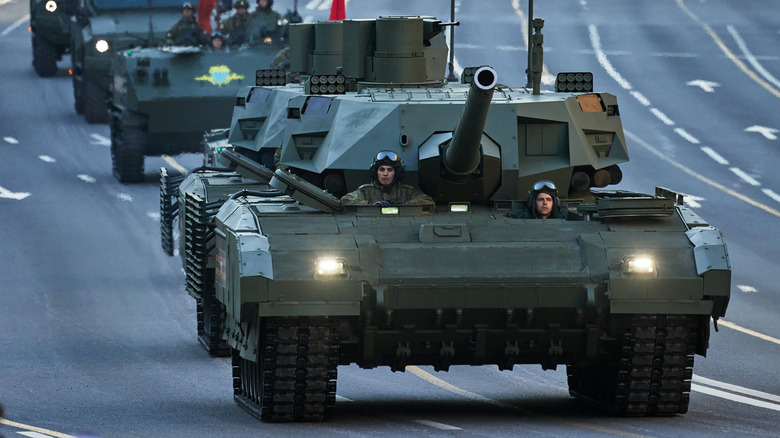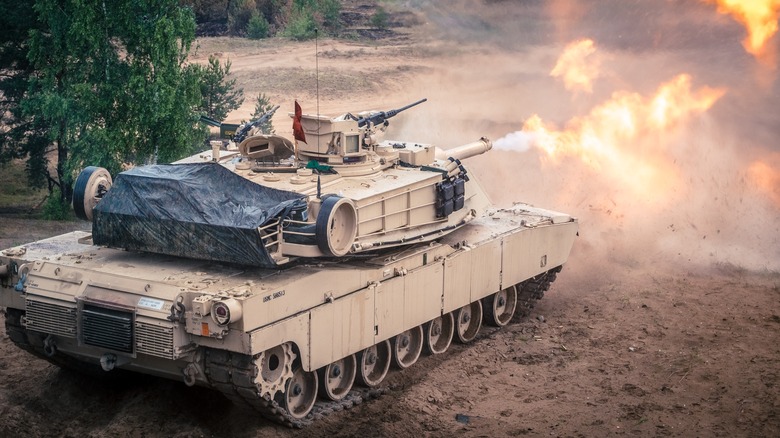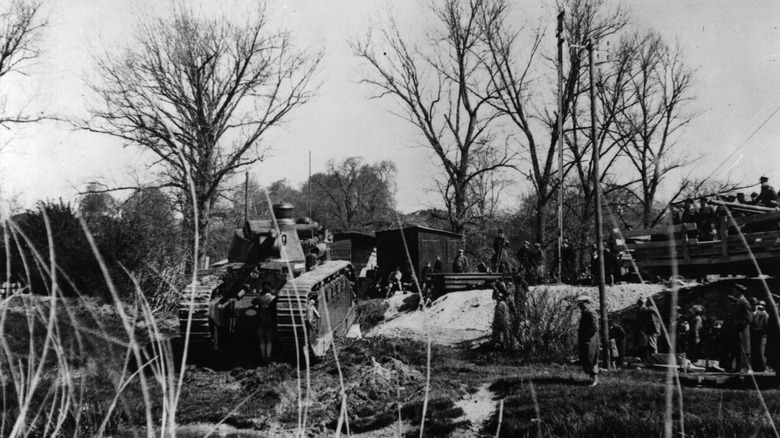5 Military Tanks That Are Way Bigger Than You Thought
When conjuring military tanks, images of powerful, armored vehicles come to mind — machines designed to withstand the harshest combat conditions and deliver formidable firepower. That said, you still might not realize just how enormous some of these tanks truly are.
The reason for their sizes is pretty straightforward. Modern tanks need thick, layered armor to protect against a variety of threats, from anti-tank missiles to improvised explosive devices — which, of course, means significant weight and bulk. They also need to house powerful engines capable of moving their massive frames across harsh terrain, from muddy battlefields to regular roads. They also need to hold all the weaponry and tech. Main guns with large calibers, along with automated loading systems, require substantial room.
All that technology and firepower, but are tanks useless in the modern age? That's a different conversation altogether, but one worth checking out. In the meantime, let's take a look at how big some popular tanks really are.
M1 Abrams
General Dynamics developed the M1 Abrams, which is considered one of the best tanks ever made. It was introduced into U.S. military service in 1980 to replace the aging M60 tank, mainly in anticipation of warfare against the Soviet Union. Over time, the Abrams actually did see conflict in wars ranging from the Gulf War to the current crisis in Ukraine. It's no doubt a popular tank. In fact, IMDb has a whole list of movies tagged with the "M1 Abrams Tank" keyword, from Transformers to Godzilla. But even Hollywood might not prepare you to the actual scale of this tank. The Abrams is 32 feet long with the gun pointed forward, 12 feet wide, and almost 8 feet tall. Its massive armor brings the total weight to about 71.2 tons! Guinness World Records even awarded the M1A2 Abrams the title of "Heaviest tank (present day)."
Besides the impressive size, the M1 Abrams also has some other interesting features. Unlike most diesel-driven tanks, the M1 Abrams tank uses a gas turbine instead of a diesel engine. The Honeywell AGT1500 gas turbine engine produces 1,500 hp, allowing the mammoth tank to reach speeds of 45 mph.
The incredible size of the M1 Abrams is also its biggest weakness. The tank's enormous weight limits its transportation, which can create logistical issues. The Pentagon's Director of Operational Test and Evaluation said in an interview with Defense News, "the M1A2 SEPv3 is not transportable by current recovery vehicles, tactical bridges or heavy equipment transporters."
Leopard 2
Germany's Leopard 2's story began in the 1970s, during the Cold War, when some German manufacturers (including the now-famous Porsche) contributed to its design. The Leopard 2 first entered service in 1979 and has since received all kinds of improvements to remain a significant player in modern combat.
It is powered by a turbocharged diesel engine which, like the Abrams, produces 1,500 hp. This engine allows the tank to reach speeds of up to 42 mph, making it one of the fastest tanks in service. The Leopard 2 can travel 342 miles on a full tank, too. The most impressive numbers, however, belong to the dimensions of the tank. When the gun is pointed forward, it is nearly 33 feet long, 12 feet wide, and 8 feet tall. Weighing roughly 64.5 to 67 tons, it too belongs to the 10 of the largest military tanks ever built list.
The Leopard needs to be this big to accommodate all its equipment; The tank's primary weapon is a 120mm Rheinmetall Rh-120 smoothbore cannon capable of firing rounds like the DM63, which can pierce armor up to 750 millimeters. It also has two 7.62mm machine guns. When it comes to armor, the Leopard 2 has a modular design made with composite materials, which makes it easy to do simple modifications and repairs. The Leopard has a price tag to match its size, too — the most recent variant, the Leopard 2A8, costs approximately $30 million.
Challenger 2
The Challenger 2 entered U.K. military service in July 1994, and this is one battle tank that has seen a lot of action in countries like Bosnia, Kosovo, and Iraq. Because it was so widely used, you're bound to come across it in pop culture — from movies to magazines. But it still won't compare to seeing the real thing and appreciating how massive it is.
The Challenger 2 weighs 64 tonnes and can reach a combat weight of 75 tonnes when equipped with extra armor modules. It's 44 feet long (gun forward), 14 feet wide, and 8 feet tall — the dimensions alone would strike fear into the hearts of enemies. The tank is driven by a V12 diesel engine with 1,200 hp, so despite being this large, it can reach speeds of up to 37 mph on the road and 25 mph off-road. The Challenger has a range of 340 miles, thanks to a 1,727-liter fuel tank.
The Challenger 2 is also one of the most heavily armed tanks of all time — it's primary weapon is the 120mm L30A1 rifled cannon, which can use High-Explosive Squash Head (HESH) ammunition. It also includes a 7.62mm chain gun and a 7.62mm machine gun. Taking full advantage of its size, the Challenger can hold 49 main gun rounds and 4,200 rounds of 7.62mm ammunition. The tank also has an upgraded Dorchester Level 2 armor, an evolution of the Chobham armor used on the Challenger 1.
T-14 Armata (Russia)
The T-14 Armata is Russia's most modern main battle tank, supposed to replace outdated Soviet-era tanks like the T-72, T-80, and T-90. This battle tank truly lives up to the "bigger than you thought" theme — it weighs in at around 55 tons, has a length of around 28.5 feet, a width of 11.5 feet, and a height of approximately 11 feet. The T-14 is moved by a 1,500-horsepower turbocharged diesel engine, which can achieve speeds of up to 50 mph. It also has an operational range of more than 300 miles, making it both swift and agile for its size.
The T-14's main weapon is a 125mm smoothbore gun, but you might find a 152mm main cannon in some models. When it comes to secondary arms, the Armata has a Kord 12.7mm machine gun and a PKTM 7.62mm machine gun.
Despite the firepower, the T-14 has had little deployment. Initial reports in 2019 indicated that only a few numbers had been made and tested. The British Ministry of Defense acknowledged that the T-14 is ready for active duty in 2024, but Russia not been keen to use it in the Ukraine conflict because of the cost and the chance that the tank might be captured and examined by Ukrainian troops.
The cost concern is a bit ironic — The base model is expected to cost roughly $3.75 million, with complex models going up to $5 million, which is significantly low when compared to other main combat tanks.
Char 2C
The Char 2C, a French super-heavy battle tank, is one of the largest tanks to ever enter service. Having the tank designed and built by FCM, a ship-building business, says a lot about how ambitious it was when it came to size. The tank originally had 6-cylinder Mercedes engines, but it was so big that these engines were eventually replaced by 250-hp Maybachs — two of them! Even with its large weight, the Char could reach a top speed of 7.5 mph. Nothing to write home about but, surprisingly, somewhat maneuverable compared to other tanks at the time. To further drive home how big this tank was, the Char 2C even needed a 12-person crew. But how big was it really?
The tank was 33.8 feet long, 13.1 feet high, and 9.7 feet wide, and weighs between 69 and 77 tons. The Char 2C's massive size and weight were both a blessing and a curse — perfect for breaching defended locations, but it was too heavy and difficult to move. Its weight actually made it one of the heaviest operational tanks until the Tiger II was introduced in 1944.
The tank has a 75mm APX 1897 cannon and four 8mm machine guns, one of which was in the rear turret. Its armor was also impressive for its day — 45mm on the front and 35mm surrounding the main turret.





